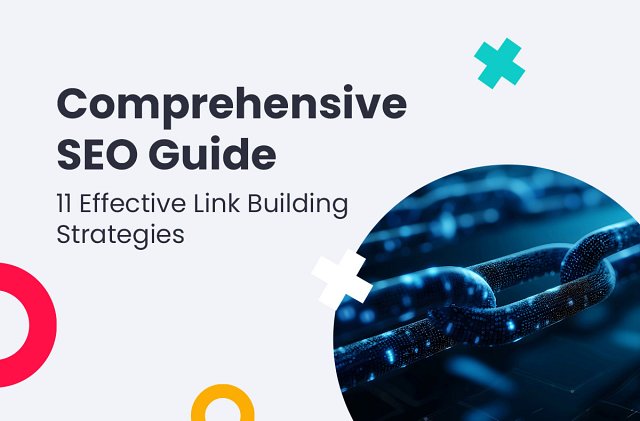(19 min. read)

Understanding the Basics of Link Building
At its basic form, link building is a process of acquiring hyperlinks from other websites to your own. It’s a fundamental part of Search Engine Optimization — these links are a primary factor that search engines like Google use to determine the quality and relevance of a website. Each link is perceived as a vote of confidence from one site to another, signifying the linked content’s value and credibility.
If you want your website to position highly on search results, strategic link building is a must. High-quality links drive direct traffic to your site while increasing its authority and trustworthiness in the eyes of search engines. This, in turn, translates to higher rankings on search engine results pages, or SERPs, allowing your website to reach a wider audience.
However, note that not all links are created equal. The evolution of search engine algorithms has led to a greater emphasis on the quality and authenticity of links, rather than their pure quantity. Links from websites with high authority will contribute more link equity to your pages than links from low-authority sites. The relevance of linking sites and the context within which your links are placed will also significantly impact your site’s SEO. As such, effective link building today requires a strategic approach that makes sure that each link adds real value to your online presence.
Types of Links: Dofollow vs. Nofollow
For SEO purposes, we can divide all hyperlinks into two types: dofollow links and nofollow links.
Dofollow links are the default state of a link. They do not have a specific attribute that marks them as dofollow — the absence of a nofollow attribute is what makes them dofollow. These links are crucial for SEO, as they pass on link equity, or “link juice”. This means that when a website links to another with a dofollow link, it’s passing on a portion of its credibility to the linked site. Search engines use this equity as a key factor in determining page ranking.
Dofollow links are best used when linking to reliable and relevant content that you want to endorse or give credit to. They are instrumental in building your website authority and improving positioning. However, be careful what you link to with dofollow links, as linking to less reputable sites could have an adverse effect on your ranking.
Nofollow links include an HTML attribute ‘rel=”nofollow”’, which was introduced by Google in 2005. It instructs search engines to ignore a link in terms of passing on link equity, originally designed to combat spam and untrustworthy content. However, while these links don’t directly contribute to your search engine rankings, they can still be valuable.
In 2019, Google evolved their approach to the “nofollow”, “ugc”, and “sponsored” tags, treating them more as hints than directives, meaning they won’t be fully ignored by search engine crawlers. The exact impact nofollow links have on SEO isn’t fully disclosed by Google.
Nofollow links are typically used when linking to unverified sources or user-generated content, as well as sponsored links and any site which you do not want to implicitly endorse. They are an essential tool for maintaining the integrity of your site’s link profile. Most sites, for example, automatically assign the nofollow attribute to all hyperlinks posted in comments or elsewhere by users, in case they link to content you don’t want to associate your site with.
Proven Link Building Strategies
There are many approaches to link building, with a whole range of techniques that webmasters use to gather high-quality backlinks. Each method offers its own advantages and can be tailored to fit different objectives and industries.
PRO TIP:
Ensuring adherence to search engine guidelines is essential for maximizing SEO efficiency. It's crucial to steer clear of Black Hat SEO techniques, which attempt to manipulate search engine algorithms, as they can lead to severe penalties for your site when discovered.
Without further ado, let’s explore some of the most popular proven link building techniques.
Earning Backlinks
Creating high-quality, engaging content is a well-known technique for attracting backlinks naturally. This can include running a blog, being active on social media, performing original research, sharing useful infographics, etc. You can incorporate modern content formats like short-form videos or podcasts to promote user engagement — an important factor in establishing link attractiveness. While these are often hosted on external platforms, embedding them into your site may create additional link building opportunities, as people link to your site to share the embedded content.
Start with researching your audience’s interests and information gaps — use tools like Google Analytics to gauge content trends and preferences in your niche. Implement relevant keywords and effective meta tags in your content, and make sure it’s structured for readability with headers, bullet points, and short paragraphs.
Once your content is created and published, don’t forget to actively promote it through social media, email marketing, or outreach to influencers and websites in your niche. The key is to produce content that is valuable to your audience and worth linking to as a resource.
Guest Blogging
Writing an article or blog post for other websites in your industry can be a powerful way to gain links. This technique involves creating valuable content for another site, with a link back to your own.
First, you’ll need to identify authoritative blogs and websites in your niche. Look for sites that have a high domain authority and active audiences. Engage with the websites through social media, blog comments, or email. Building a rapport can increase the likelihood of your guest post being accepted.
Prepare compelling pitches, tailored to the host blog’s audience and content style. Make sure to propose unique and insightful blog post topics that complement their existing content — don’t repeat the blog post topics they’ve already covered, unless you have a valuable contribution to add.
When writing your guest blog post, adhere to the host blog’s guidelines and maintain an overall high quality of content. Remember that you must always remain transparent and disclose the relationship between your site and the publisher under each guest post. Include a link back to your website in a manner that feels natural and adds value to the article. Avoid overstuffing your guest post with links to your site — it won’t be effective and will most likely be rejected by the site owner.
Broken Link Building
Broken link building, also known as reclaiming lost links, involves finding broken links on other websites and suggesting your own content to the site owner as a replacement. Use tools to identify broken links relevant to your niche, like Ahrefs Broken Link Checker or SEMrush — they can quickly crawl websites and identify links that return a 404 error.
Focus on websites relevant to your industry and with high domain authority for better SEO impact. If a site is regularly updated, it indicates active management and, as a result, a higher likelihood of broken link building working.
Before creating replacement content, analyze the original content that the broken links pointed to (using tools like the Wayback Machine, if necessary). Make notes and develop content that matches or exceeds the quality and relevance of the original. Make sure it provides unique value and is up-to-date.
When the content is ready, reach out to the site owner with a personalized email. Begin by kindly informing them about the broken link and its potential impact on their site’s user experience. Subtly suggest your content as a replacement for the broken link — emphasize how your content is relevant and beneficial to their audience.
If you don’t receive a response, don’t be afraid to send a follow-up after a week or so, but avoid being too pushy with your broken link building efforts.
Leveraging Social Media for Link Building
Engaging with the audience on social media platforms can indirectly lead to link building opportunities. Actively participate in discussions and provide valuable insights, and — when appropriate — link to your site as a resource. Share industry news, comment on posts made by users, and answer questions from the community. This helps in building your reputation as an industry expert in general.
Social media links are typically nofollow, but they provide indirect benefits to your SEO, such as increased visibility, which leads to generation of natural backlinks. As such, they are still very valuable to cultivate for both your website and your brand as a whole.
You can engage with influencers and potential customers to build connections that can lead to organic sharing of your content. Joining groups or forums relevant to your niche is also a good idea. Remember, you’re not there to advertise, but to participate by contributing valuable content.
Regularly monitor mentions of your brand and respond promptly. Use tools like Mention and similar services to gain easy access to any unlinked mentions.
Outreach
Collaborating with influencers and other websites in your field can help in gaining relevant links and enhancing content reach. Identify and connect with valuable entities — propose collaborations that can include them linking to your content or sharing it with their audience. Be prepared to, in turn, do the same for them.
Tools like BuzzSumo can help you spot outreach opportunities, but it’s worth doing some manual work and finding creators that are popular in your niche and align well with your brand values. Prepare personalized outreach messages in which you explain why a collaboration would be mutually beneficial.
There are many forms of collaborations, including writing a guest post, sponsored segments, co-creating content, and more. However, make certain your proposal is relevant and adds value to the influencer’s content strategy. Focus on building long-term relationships rather than one-off interactions.
HARO (Help a Reporter Out)
HARO is an online service that helps journalists connect with industry experts — reporters seek insights and quotes for their stories, while experts can earn media coverage and build links. Register as a source on HARO and regularly monitor the queries that align with your expertise. Queries are categorized by industry, making it easier to identify opportunities.
When responding to a reporter, be concise and provide valuable information. Precisely address the reporter’s needs while positioning yourself or your brand as an authority in the subject. Remember that journalists often work on tight deadlines, so responding promptly to queries is expected. Concise, relevant, and authoritative responses can increase your chances of being featured.
Consistently providing valuable insights can help you build relationships with journalists — over time, they might seek your expertise directly for future stories.
Digital PR
Digital PR involves using online media and communication strategies to increase brand awareness and online presence. This includes collaborating with influencers and journalists, as well as leveraging online events and press releases.For cooperation, choose brands and influencers that share similar values with your target audience and fit your industry.
Develop compelling, newsworthy content that is likely to capture the interest of online media outlets — this can include original research, surveys, reports, as well as major company announcements that influence the field.
Identify and reach out to relevant online publications and news sites with pitches, emphasizing how your content or story provides value to their audience. Use social media to amplify your PR efforts. Share your stories and engage with followers, encouraging influencers to spread your content.
Brand Mentions
Every time your brand gets mentioned on the internet is a potential backlink opportunity. Use digital tools to monitor the web for mentions of your brand or products — focus on finding instances where your brand is mentioned, but not linked.
Contact the authors or site owners of these unlinked mentions and request them to add a link back to your website. Emphasize the benefit for their audience in accessing additional relevant content. When creating content, try to develop it in a way that naturally encourages brand mentions and links, including proprietary data and valuable resources. Participate in industry events and community discussions, or hold webinars to promote brand visibility. The more visible your brand is, the more likely it is to be mentioned across different platforms.
Keep track of your interactions and build relationships with individuals who frequently mention your brand. This network can be a valuable asset for future link-building efforts.
Sponsored Content (Articles)
Sponsored content involves paying for your content to be published on other sites — keep in mind that, generally, such content needs to be properly labeled to maintain transparency. It’s a direct and controlled way to place your content and build links on relevant and high-traffic sites.
Identify websites and blogs that are popular among your target audience and have a strong domain authority. The platform should align with your brand’s values and have content fitting your niche. Be transparent about the sponsored nature of the content. In most cases, a link in sponsored content should contain a “sponsored” tag to avoid Google penalties for nondisclosure. Sponsored content should also be relevant and valuable to the target audience to remain SEO optimized and avoid negative reception by internet users.
You can track the performance of your sponsored content through metrics such as traffic generated or conversions — use it to analyze the effectiveness of your investment and adjust your strategy.
To make sure your link building efforts are well-managed, you can partner up with a content marketing platform like WhitePress to reach a wide range of high authority websites and skilled content writers within a few minutes using a simple and convenient interface.
Advanced Tactics for your Link Building Strategy
Now that you know how to effectively build your backlink profile, let’s proceed to more sophisticated strategies that require a better understanding of SEO. If you’re looking to take your link building efforts to the next level, these tactics are designed for you.
Skyscraper Technique
Skyscraper technique is a highly competitive SEO tactic, in which you aim to create content that is more informative, engaging, and of higher quality than your competition’s — and then you try to convince website owners to link to it instead. It’s not easy, and it requires a delicate approach, but when executed correctly, it can provide a significant boost to your backlink profile.
Start by identifying popular content in your niche that has attracted a significant number of backlinks (Ahrefs and BuzzSumo will be helpful). Look for evergreen topics with lasting relevance that aligns with your expertise at the same time. Develop content that adds significant value compared to the original piece — updated statistics, more comprehensive details, expert opinions, enhancing the visual appeal, etc.
The content should also be well-optimized for search engines with relevant keywords, combining the best SEO practices with engaging writing. When the content is ready, identify relevant sites that linked to the original content using backlink analysis tools. These are your primary outreach targets.
As with all outreach, crafting personalized messages goes a long way — especially when attempting the skyscraper technique. Every aspect of your strategy needs to be executed with the highest quality for it to work.
If there’s no response, a polite follow-up after a week or two can be effective. However, avoid being overly persistent. Pay attention to the feedback and comments received. Use this insight to further refine your content.
The Skyscraper Technique is a powerful way to build high-quality backlinks and enhance your website's SEO performance. However, it requires diligence in both content creation and outreach. When executed just right, the payoff can be substantial in terms of increased traffic and better search engine ranking.
Competitor Backlink Analysis
Analyzing your competitors’ backlink profiles can give you substantial information about how to adjust your own strategy. Start by identifying your main competitors who rank well for your target keywords — you can use tools like Ahrefs or SEMrush for detailed backlink analysis, with additional insights into where your competitors’ backlinks are coming from, their quality, and the types of content being linked.
Look for high-authority competitors' websites that are linking to your competitors. Prioritize links from relevant sites with high domain authority, since they carry more weight in SEO. Some of them might be willing to host your content as well.
Identify gaps in your own backlink profile by comparing it to your competitors’. Identify strategies your competitors are using and types of websites that are linking to your competitors but not to you. Consider guest blogging on relevant websites, and focus on content formats that have worked for your competitors.
Develop an outreach strategy to connect with the websites identified. When reaching out, propose content that is as good as or better than what they currently link to. Regularly monitor the new links you acquire. Analyze how these links affect your website’s traffic and search engine rankings.
Learn from both successful and unsuccessful attempts. Adapt your strategy based on what is working well in your industry and niche. When executed right, this tactic can help you close the gap with competitors, as well as identify new and emerging opportunities for high-quality backlinks. Don’t just replicate what others do, but instead aim to outdo your competition by providing superior content to the same audience.
Link Building Tools and Resources
Manually analyzing your or your competitors’ backlink profiles would be a difficult and extremely time-consuming task. However, with the right set of tools, you can significantly streamline this process and enhance the effectiveness of your link building strategy.
Backlink analysis tools are crucial for understanding your own backlink profile and that of your competitors. They help identify where links are coming from, the quality of these links, and new potential opportunities to build links.
Recommended tools:
- Ahrefs: Known for its extensive backlink database, Ahrefs is invaluable for backlink analysis, keyword research, competitor research, and identifying link-building opportunities. It provides one of the most comprehensive sets of tools for analyzing backlinks.
- SEMrush: Offers a complex suite of SEO tools, including backlink analysis and tracking, as well as competitor insights.
- Majestic SEO: Specializes in backlink analysis and providing detailed reports on the types and quality of backlinks.
Content research tools help in identifying trending topics, popular content formats, and the content strategies of competitors. This is essential for creating content that effectively attracts backlinks.
Recommended tools:
- BuzzSumo: Great for discovering popular content in your niche and identifying what types of content receive the most shares and backlinks.
- Google Trends: Useful for understanding search trends and topics that are currently popular, which is helpful in content creation.
Efficient outreach is critical in link building. Outreach tools help manage and automate communication with potential link partners, track responses, and nurture relationships.
Recommended Tools:
- Hunter.io: Useful for finding email addresses associated with a particular website, making it easier to connect with decision-makers.
- BuzzStream: A comprehensive tool for managing outreach campaigns, tracking conversations, and maintaining relationships with contacts.
In addition to these tools, you should always aim to stay informed about the latest trends and best practices in link building. Regularly visiting SEO blogs, participating in webinars, and joining SEO and digital marketing forums can provide valuable insights and keep you updated on industry developments.
Measuring the Success of Your Link Building Strategy
Knowing the impact of your link building strategy is essential to refine and optimize your efforts for maximum results. The most direct measure of link building success is the number of new backlinks acquired — this indicates the reach and expansion of your website's link profile.
Not all backlinks are created equal. Assess the quality of backlinks by looking at the domain authority (DA) or domain rating (DR) of linking sites. High-quality backlinks from reputable sites have a greater impact on SEO. While DA and DR are not official Google ranking factors, they provide a good estimate of a website’s link equity.
Monitor the amount of traffic each backlink drives to your website. High referral traffic from a backlink indicates relevance and engagement, which are positive signals to search engines. Keep track of the rankings for your target keywords and make adjustments as necessary to keep your content trending in searches.
Measuring Tools
There is a range of tools available for marketers to track the effectiveness of their link building. The holy grail of link building is Google Analytics — use it to track referral traffic from backlinks, monitor user behavior on the site, and measure conversions like signing up for a newsletter or making a purchase.
SEO platforms like Ahrefs or SEMrush offer a comprehensive array of functionalities that allow you to easily monitor new backlinks and analyze link quality, while also providing notifications as keyword rankings change over time. Use them to your advantage, but take note that many advanced features require a paid subscription to unlock.
Finally, make sure you’re familiar with the Google Search Console — it’s an essential tool for understanding how Google views your site. It provides data on your website’s search performance, including impressions and positioning. It’s also fundamental in fixing crawling and indexing errors, reporting issues and suggesting fixes.
Analyzing and Reporting
Create regular reports to analyze the performance of your link building strategies. Monthly or quarterly reports can help you see trends and identify areas for improvement. Always compare your link building progress with that of your competitors — understanding their link building strategies and performance can provide useful insights into industry standards and reveal new opportunities.
Evaluate the return on investment (ROI) of your link building efforts by considering the cost of link building activities against the value of increased traffic and improved rankings, as well as new conversions.
Conclusion
Search engine optimization is a complex field that is constantly changing, but a strong backlink profile remains a significant factor for search engine algorithms when assigning SERPs ranking. Link building requires a multifaceted approach, blending creativity with analytical methods to make educated decisions.
Throughout this guide, we’ve shown you some of the most effective strategies and advanced tactics for managing your link building efforts. We’ve showcased the essential tools and discussed the importance of measuring your success. Let’s summarize what we’ve learned with the key takeaways:
Quality Over Quantity — The quality of backlinks significantly outweighs the sheer number. Prioritize securing high-quality links from reputable sites to boost your SEO effectively. Gauge backlink quality using metrics such as DA or DR.
Diverse Strategies for Diverse Goals — There is no one strategy that outshines all the others. Employing a variety of link building techniques — from content creation to digital PR — allows you to cater to different objectives and audiences, diversifying your backlink profile.
Use Tools Available at Your Disposal — Utilizing the right tools for backlink analysis, content and keyword research, outreach, and success measurement will help you streamline your efforts and maximize efficiency.
The Importance of Monitoring — Continuously measuring the impact of your link building efforts through relevant KPIs (new backlinks, referral traffic, search engine rankings, conversions, etc.) is essential for discovering areas for improvement and understanding what works and what doesn’t.
Keep Flexible — SEO never settles down, and search engine algorithms are constantly changing and evolving. Stay informed and be willing to adapt your strategies if you want to achieve success.
In link building, there is no one-size-fits-all solution. What works for one website may not work for another, further highlighting the importance of experimenting and tracking results. Stay up-to-date with the latest developments by engaging with the SEO community and reading up on the latest news in the WhitePress Knowledge Base.
Adaptation and continuous improvement are your allies in navigating the complexities of link building. As you move forward, remember that successful link building is a marathon, not a sprint. It requires patience, persistence, and a commitment to quality. Embrace the principles discussed in this guide, and you will be able to achieve sustained growth and a powerful online presence. Keep pushing the boundaries and experimenting with new strategies — and always measure the results!





